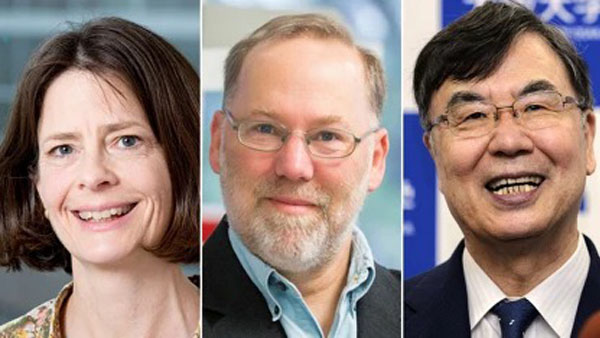By Dipak Kurmi
In 2025, the Nobel Prize in Physiology or Medicine was awarded to Japanese scientist Shimon Sakaguchi and American scientists Mary E. Brunkow and Frederick Ramsdell for one of the most revolutionary discoveries in modern immunology — the identification and understanding of peripheral immune tolerance. Their work unveiled the critical role of a special class of immune cells, called regulatory T cells, in maintaining balance within the body’s defense system. This breakthrough not only solved a long-standing mystery in biology but also opened the doors to life-saving therapies for autoimmune diseases and cancers, transforming the way we understand immunity itself.
The Question That Redefined Immunology
For decades, scientists have been fascinated by a paradox of the immune system: how does it wage war against invading viruses, bacteria, and other harmful microbes without mistakenly attacking the body’s own tissues? The immune system’s primary warriors — the T cells — are trained to distinguish between “self” and “non-self.” They are crucial in targeting pathogens and eliminating infections. But occasionally, this line blurs. When T cells mistakenly recognize the body’s own cells as foreign, the result is catastrophic: autoimmune diseases such as lupus, rheumatoid arthritis, type 1 diabetes, and multiple sclerosis emerge.
By the 1980s, researchers had already identified one key mechanism called central tolerance. This process, which takes place in the thymus (the organ where T cells mature), ensures that immature T cells capable of attacking the body’s own proteins are eliminated before they can cause harm. However, this explanation was incomplete. Scientists noticed that even with central tolerance functioning properly, autoimmune diseases could still arise. There had to be another layer of protection — an external mechanism ensuring that the immune system, once fully developed, remained under control.
This led to the hypothesis of peripheral tolerance: the idea that specialized T cells might act as regulators, policing the immune system outside the thymus. Yet, early studies failed to provide convincing evidence, and the concept fell out of favor. Most immunologists moved on. But not Shimon Sakaguchi.
The Rebel Who Revived a Forgotten Theory
In the late 1980s and early 1990s, when the notion of suppressor or regulatory T cells had been largely abandoned, Sakaguchi continued to explore the possibility that such cells might exist. Against prevailing skepticism, he designed a series of experiments that would change immunology forever.
Sakaguchi’s approach was elegant in its simplicity. He surgically removed the thymus from newborn mice — the very organ where T cells develop. His hypothesis was straightforward: if the thymus were removed, the mice would fail to produce mature T cells and would, therefore, have weakened immune systems. What happened next was startling. When the surgery was performed just three days after birth, instead of immune deficiency, the mice developed severe autoimmune diseases. Their immune systems went into overdrive, attacking their own tissues and organs.
This unexpected result puzzled Sakaguchi. Something, he reasoned, was missing — a subset of T cells that normally kept the immune system in check. To test this, he isolated T cells from genetically identical healthy mice and injected them into the thymus-removed mice. The outcome was striking: the autoimmune symptoms vanished. This provided the first clear evidence that a distinct population of T cells acted as immune “police,” suppressing overactive immune responses and preventing self-destruction.
Still, identifying these cells was no easy task. It took Sakaguchi nearly a decade to isolate and characterize them. In 1995, he published a landmark paper that introduced the world to regulatory T cells (Tregs). These cells, characterized by a unique molecular marker called CD25, were shown to play a pivotal role in maintaining peripheral tolerance — the process by which the immune system avoids attacking its own body.
The discovery was groundbreaking, yet skepticism persisted. Many researchers doubted whether these Tregs were a distinct class or simply an experimental artifact. It would take the efforts of two American scientists — Mary E. Brunkow and Frederick Ramsdell — to provide the missing genetic link that confirmed Sakaguchi’s theory beyond doubt.
The Genetic Key: The FOXP3 Gene
Around the same time that Sakaguchi was studying his mice, Brunkow and Ramsdell, working at the biotech firm Celltech Chiroscience in the United States, were investigating a mysterious autoimmune disorder found in a strain of mice known as scurfy mice. These mice were frail, with scaly, flaky skin, and survived only a few weeks after birth. Their immune systems appeared to be attacking their own tissues, but the underlying cause was unknown.
Brunkow and Ramsdell embarked on an ambitious mission to locate the gene responsible for this devastating condition. Their search was like looking for a needle in a haystack — the mouse genome contained over 2.7 billion nucleotides. But through careful mapping, they narrowed the search to a region of about 500,000 nucleotides and identified 20 potential genes that might be causing the autoimmune response.
Their painstaking work paid off in 2001 when they pinpointed the culprit: a mutation in the FOXP3 gene. This discovery not only explained the autoimmune condition in scurfy mice but also linked it to a rare and fatal human disease known as IPEX (Immune dysregulation, Polyendocrinopathy, Enteropathy, X-linked syndrome). In humans with IPEX, mutations in the same gene caused uncontrolled immune activation, leading to severe inflammation and organ failure in early childhood.
The revelation of the FOXP3 gene was the missing piece that connected the genetic and cellular aspects of immune regulation. It provided Sakaguchi with the molecular key he needed to confirm that FOXP3 was essential for the development and function of regulatory T cells. Within two years of Brunkow and Ramsdell’s discovery, Sakaguchi demonstrated that FOXP3 acts as the master control gene — the “on switch” — for regulatory T cells. Without it, these cells could not develop, and the immune system would spiral into chaos.
How the Discovery Transformed Medicine
Once the role of regulatory T cells and the FOXP3 gene became clear, immunology entered a new era. Researchers realized that these cells were not just passive bystanders but active architects of immune balance. They prevent autoimmune reactions, moderate inflammation, and help maintain harmony between defense and tolerance.
However, like any powerful system, this regulatory mechanism can be exploited. Tumors, for example, can recruit large numbers of regulatory T cells into their microenvironment. These Tregs then suppress other immune cells that would otherwise attack the cancer, effectively creating a shield around the tumor.
Dr. Hasmukh Jain, a hematologist at Tata Memorial Hospital, explains: “When a cancerous tumor contains a high concentration of regulatory T cells, they prevent the rest of the immune system — particularly cytotoxic T cells — from killing the malignant cells. This presents a major challenge for immunotherapies such as CAR-T cell therapy.”
CAR-T cell therapy, which involves genetically modifying a patient’s own T cells to recognize and destroy cancer cells, can be hindered by the suppressive activity of Tregs. To overcome this, researchers have developed strategies to temporarily inhibit regulatory T cells, allowing cancer-fighting immune cells to function more effectively. Many of today’s most promising cancer immunotherapies, including immune checkpoint inhibitors, work on this principle — reducing Treg activity to enhance the body’s natural ability to eliminate tumors.
Yet, this is a double-edged sword. When Tregs are suppressed too much, the immune system can turn on itself, leading to autoimmune side effects such as colitis, dermatitis, or thyroiditis. Balancing immune activation and suppression remains one of the biggest challenges in modern oncology.
Conversely, boosting Treg activity holds promise for treating autoimmune diseases and in organ transplantation. Clinical trials are currently exploring therapies that promote the formation of regulatory T cells in patients with conditions like multiple sclerosis, lupus, and type 1 diabetes. By enhancing Treg numbers or function, scientists hope to calm the overactive immune systems of these patients, restoring balance without the need for broad immunosuppressive drugs.
In another line of research, scientists are experimenting with Treg-based cell therapy — similar in concept to CAR-T therapy, but with the opposite goal. Here, regulatory T cells are isolated from a patient’s blood, genetically modified in the laboratory to enhance their suppressive abilities, and then reintroduced into the body to dampen harmful immune responses. This approach is being investigated to prevent organ rejection after transplantation and to treat autoimmune diseases where inflammation must be controlled.
A New Frontier in Immunology
The discoveries of Sakaguchi, Brunkow, and Ramsdell have revolutionized our understanding of immune homeostasis. What was once considered a purely offensive system — designed only to attack — is now recognized as a finely balanced network that requires both aggression and restraint. Regulatory T cells are the guardians of this balance, ensuring that the immune system’s power does not turn inward.
Their work has illuminated the fundamental truth that health depends as much on the body’s ability to tolerate itself as it does on its ability to fight outsiders. Diseases of excess immunity — autoimmunity — and diseases of insufficient immunity — cancer — are now understood as two sides of the same coin.
Today, three decades after Sakaguchi’s first experiments, the impact of these findings continues to grow. Regulatory T cells have become one of the most studied components in immunology, and FOXP3 remains a central focus of genetic and therapeutic research. From vaccines and cancer treatments to regenerative medicine and transplantation science, the concept of immune regulation touches every frontier of modern biomedical research.
In recognizing Shimon Sakaguchi, Mary E. Brunkow, and Frederick Ramsdell with the Nobel Prize, the scientific community honors not only their brilliance but also their persistence — their willingness to challenge dogma, to question established beliefs, and to pursue the truth hidden within nature’s complexity.
Their work reminds us that the immune system, like life itself, thrives in balance. It must know when to fight, and equally, when to hold back. And it is in that delicate dance between destruction and tolerance that our survival depends — a dance choreographed, as we now know, by the quiet guardians called regulatory T cells.
(the writer can be reached at dipakkurmiglpltd@gmail.com)




